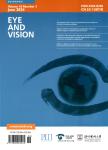Investigation of corneal topographic and densitometric properties of Wilson's disease patients with or without a Kayser-Fleischer ring
作者机构:Department of OphthalmologyUniversity of Health SciencesDiyarbakir Gazi Yasargil Research and Training HospitalDiyarbakırTurkey Department of Internal MedicineUniversity of Health SciencesDiyarbakir Gazi Yasargil Research and Training HospitalDiyarbakırTurkey
出 版 物:《Eye and Vision》 (眼视光学杂志(英文))
年 卷 期:2021年第8卷第2期
页 面:67-74页
核心收录:
学科分类:1002[医学-临床医学] 100212[医学-眼科学] 10[医学]
主 题:Wilson Kayser-Fleischer ring Corneal densitometry
摘 要:Background:To investigate the topographic measurements and densitometry of corneas in Wilson’s disease(WD)patients with or without a Kayser-Fleischer ring(KF-r)compared to healthy ***:This cross-sectional study included 20 WD patients without a KF-r(group I),18 WD patients with a KF-r(group II),and 20 age-matched controls(group III).The Pentacam high resolution imaging system is used to determine corneal topographic measurements and ***:Mean age for groups I,II and III was 25.40±6.43 years(14-36 years),25.38±6.96 years(16-39 years),23.60±6.56 years(17-35 years),respectively(P=0.623).There was no significant difference between the groups in terms of the anterior corneal densitometry values(P0.05),while the 6-10mm and 10-12 mm mid stroma and the 2-6 mm,6-10 mm,and 10-12 mm posterior corneal densitometry values in group II were significantly higher than those in groups I and III(for all values,P0.05).However,the 10-12mm posterior corneal densitometry values in group I were also significantly higher than those in group III(P=0.038).The central corneal thickness(CCT),thinnest corneal thickness(tCT),and corneal volume(CV)values in groups I and II were significantly lower than those in group III(for CCT values,P=0.011 and P=0.009;for tCT values,P=0.010 and P=0.005;for CV values,P=0.043 and P=0.029).Conclusion:In WD patients with a KF-r,corneal transparency decreased in the peripheral posterior and mid stromal corneal layers;for these patients,corneal transparency may be impaired not only in the peripheral cornea but also in the paracentral cornea.



